By literally any measure the healthcare technology sector had an exceptional 2021. According to Rock Health, $29.1 billion was invested in 729 companies with an average round size of $39.9 million – all were highwater marks for the sector. There were 88 “mega rounds” (greater than $100 million) which further underscores both the attractiveness of the sector to investors and that we are in an “Anoint the Winner” phase for this category. Globally, StartUp Health identified $44 billion of investment in 990 companies.
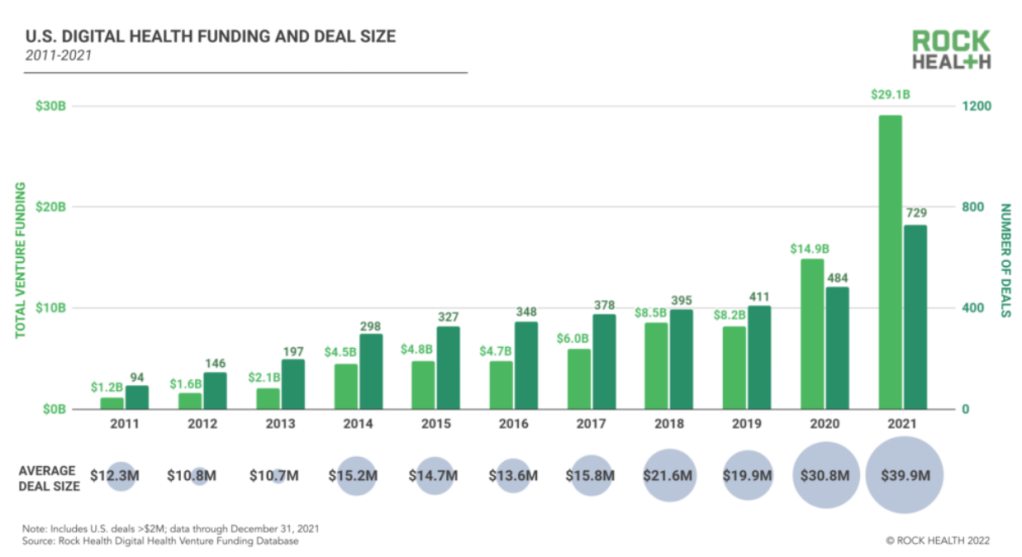
The debate now turns toward what 2022 will look like as entrepreneurs and investors attempt to assess the impact of a rapidly deteriorating geopolitical environment and a less accommodating financing climate. The answer to this question directly informs how companies should think about growth and relevant milestones. Was 2021 an aberration or can we expect continued robust support for healthcare technology companies?
Arguably, the one of the more conservative approaches to determine how much will be invested in 2022 would be to simply look at the trailing five-year average for number of deals and average round size, and then assume that the sector immediately reverts to the mean. Such a simplistic approach would conclude that 2022 would look much more in line with pre-pandemic investment levels of $10 – $12 billion; that is, for the digital health sector, there would be just over 100 Series A financings that raise ~$12.5 million each, nearly 80 Series B rounds with an average round size of ~$30 million, etc. A trailing 10-year “look back” would suggest annual levels nearly half as much given far fewer companies and considerably smaller round sizes.
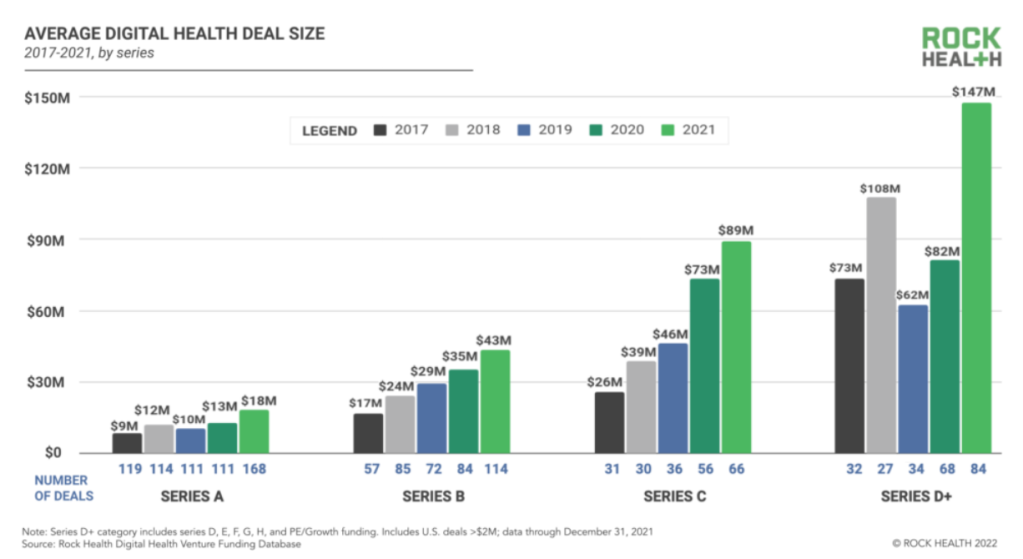
But that is not what is going to happen. Healthcare technology venture investing is now nearly 10% of all venture capital investments, up from 3-5% ten years ago. The pandemic has been a massive accelerant for technology adoption in healthcare. The strategic urgency to re-architect the healthcare system is palpable: the next two years will define the industry’s agenda for the next five years, and the next five years will define the next twenty years.
Therefore, another approach to determine what may unfold this year is to look at the companies which raised capital over the last two years and assume a “graduation rate” (that is, raise a subsequent round) consistent with the last five years (~80% of Series A companies go on to raise a Series B, ~50% of those raise a Series C, etc.) but that round sizes moderate to pre-pandemic 2019 levels but assume a consistent percentage of “mega rounds.” While 57% of the capital invested last year was in “mega rounds,” they only accounted 12% of the financings. The average size of a “mega round” was $190 million. Under these assumptions, the overall activity in 2022 could be $21 – $23 billion.
Simply annualizing preliminary year-to-date investment activity through February puts the sector on pace for $22.8 billion invested in 630 companies, perhaps due to later stage crossover investors moderating their activity.
Of course, the level of investment could be quite a bit lower should the capital markets really freeze up. One might expect to see the introduction of more onerous investment terms (increased liquidation multiples, seniority) before there is a dramatic reduction of the stated valuations. Additionally, there may simply be fewer companies financed: last year there were 729 financings in this sector, yet the five-year trailing pre-pandemic average was 400 companies. Should any of these companies stumble, expect to see a marked increase in private-to-private M&A activity. In 2021, there was on average 23 M&A transactions per month in the digital health sector according to Rock Health. Solomon Partners tallied 326 M&A transactions with an aggregate disclosed value of $152 billion inclusive of public companies. Of course, there are no shortage of companies from which to pick.
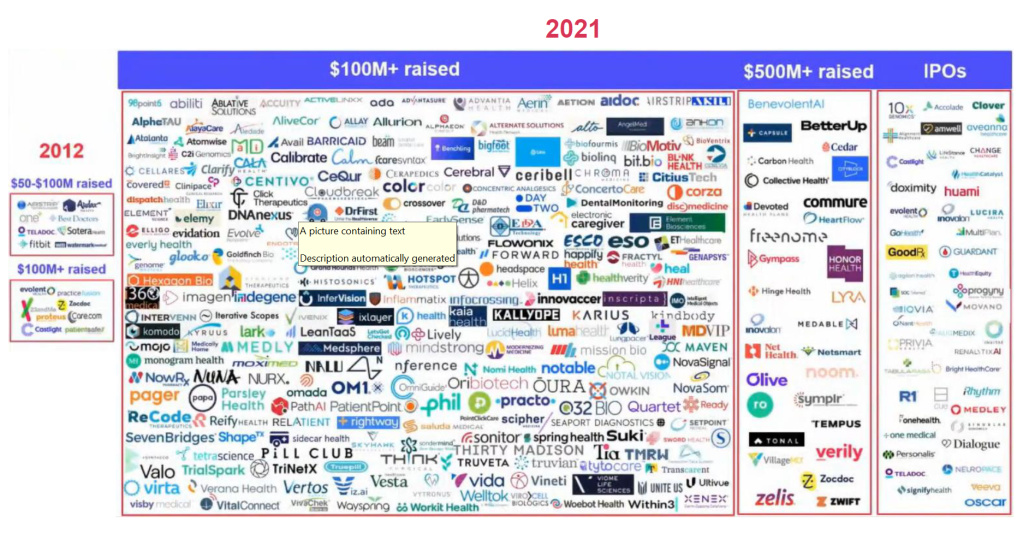
Notwithstanding all the exciting private market activity, the story is quite a bit different in the public markets, which have frowned on the healthcare technology sector these past few months. The “Anoint the Winner” phase may quickly fade into the “Prove It” phase as well-capitalized and recently public companies struggle to become cashflow positive. Investor sentiment seems to have moved from “growth at all costs” to telling a “path to profitability” story.
The public equity markets have discerned a significant difference between companies that sell technology solutions to pharma and providers, which performed relatively well in 2021, from companies focused on employers and payors. Value-based care and technology-enabled companies also struggled mightily in 2021, perhaps due to having had such a strong 2020 but also analysts have expressed concerns about the capital intensity of these models, ability to manage risk, and when these companies become profitable.
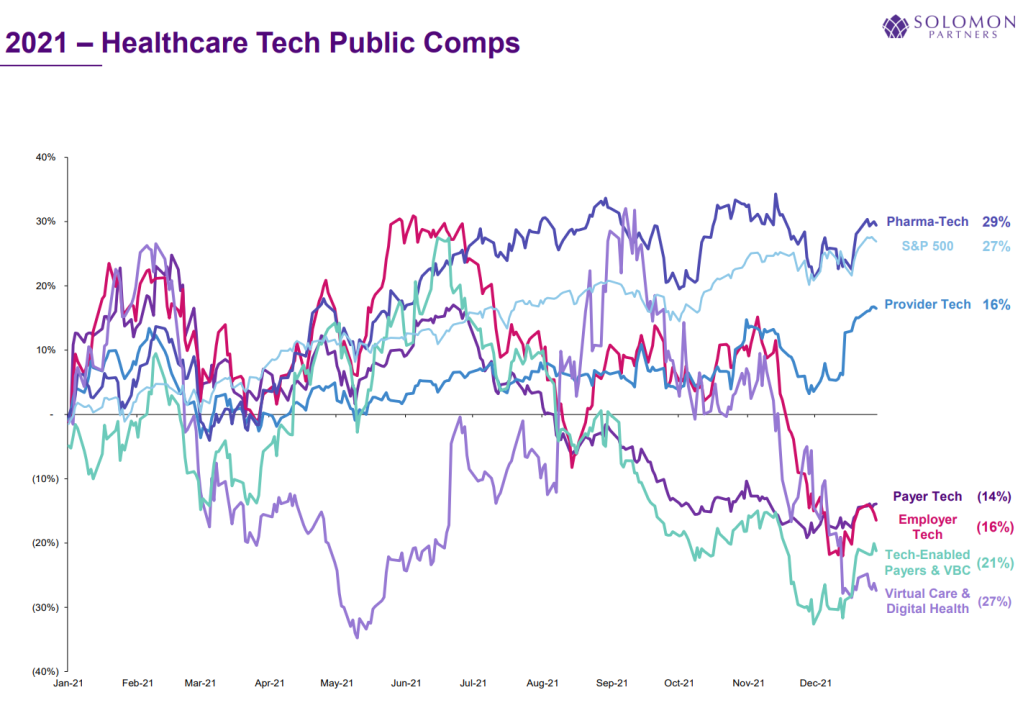
The news was even more challenged for the class of 2021 healthcare technology IPOs. Other than Doximity, all the companies underperformed the S&P 500 index, with six of them trading down by more than 20%. Since their market peaks, the public digital health, telehealth, technology-enabled primary care, and start-up health insurance companies have lost nearly $190 billion of market capitalization as of the end of January 2022, according to an analysis by A2 Strategy Group. Absent even a modest recovery, later stage investors may pause to see how the well-capitalized private companies perform over the course of the year. Additionally, many crossover investors may simply choose to invest in some of these public “fallen angels” versus continuing to pursue later stage private opportunities.
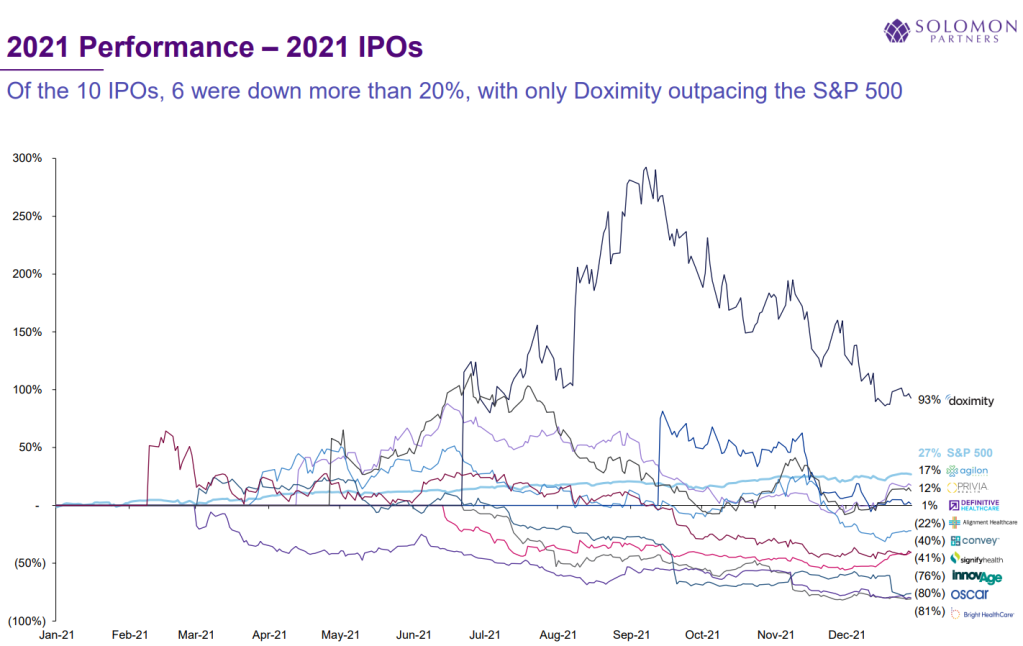
Setting aside these short-term atmospherics, venture investors are looking 5-10 years forward and see profound opportunities as the healthcare industry is re-architected. The transition to value-based care, improved data liquidity, empowerment of the healthcare consumer, more robust infrastructure, and innovation to improve labor productivity are powerful themes to drive new company creation.
And these markets are enormous. For instance, McKinsey estimates that over $265 billion of healthcare services will shift from traditional care settings to the home. That represents nearly one-quarter of all Medicare fee-for-service and Medicare Advantage spend. This is a 3-4x increase in what is being spent in the home today – and much of that capability needs to still be built and deployed. The home is one of the great frontiers to be conquered and entrepreneurs today will make that a reality.

Pingback: 1Q22: Bob and Weave… | On the Flying Bridge
Pingback: Meet You in the Healthcare Metaverse…? | On the Flying Bridge